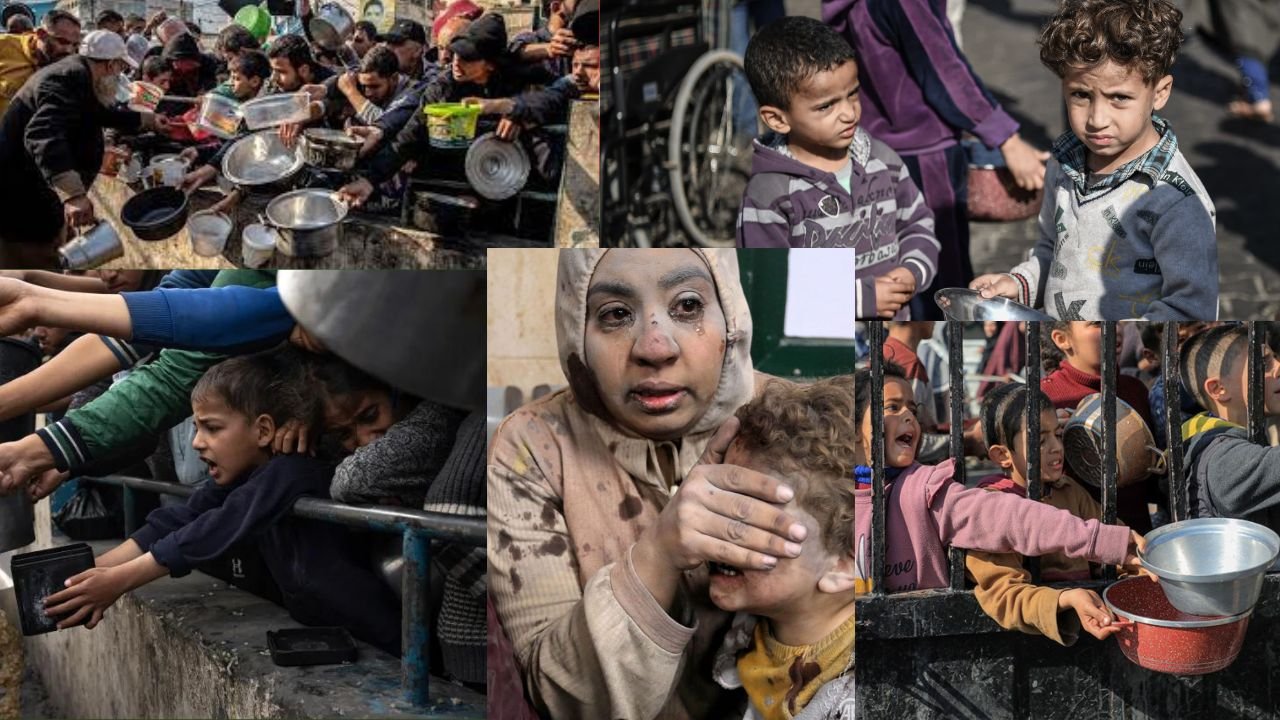The people in Gaza who have managed to escape death by Israeli strikes in a war that has been forced on them are now dying of hunger and starvation. Videos of bread made out of animal feed and kids collecting flour accidently spilled on the ground are making rounds on social media leading to the drive for the ceasefire taking momentum. As recently as February 20, the UN Food Agency put a pause on its deliveries in the North of Gaza until the conditions are in place that allow for safe distributions.
Families in Gaza are forced to forage for scraps of food left by rats and eating leaves out of desperation to survive with nearly five months of war and rapidly declining aid supplies leaving all 1.1 million children in Gaza facing starvation, Save the Children said.
Hind Khoudary, the Palestinian Journalist in Gaza reporting from the ground, took to her Instagram to plead to the world to airdrop food in Gaza as people have started eating leaves and are making bread out of animal feed. “People are eating leaves and animal food. “I am calling the world and all the countries to Airdrop food to Gaza,” she said in an Instagram story.
Ali Jadallah, a photojournalist from Gaza, shared how her mother, a dialysis patient, is suffering because of the food and health crisis in Gaza. Finding food in Gaza is the most difficult thing nowadays.
Journalist Anas Ajmal reported how he has been searching for a meal but could not find one in days.
“Gaza has become a place of death and despair,” stated the Secretary-General for Humanitarian Affairs Martin Griffiths.
Videos of hundreds of desperate and hungry Gazans heckling the UNRWA aid truck emerged from the besieged strip. Many reports from Gaza have already been warning the global authorities of impending famine and loss of lives due to hunger.
Back in December, Human Rights Watch had accused the Israeli government of intentionally starving civilians in Gaza as part of its offensive in the besieged Palestinian territory. “The Israeli government is using starvation of civilians as a method of warfare in the occupied Gaza Strip, which is a war crime,” the New York-based group charged in a report.
Additionally, The Times posted a report about the famine-stricken conditions of the people of Gaza where a mother revealed how her breasts no longer produce milk because of long periods of starvation and how her children are suffering immensely. Explaining the food crisis the article explained how Gazans are forced to eat rotten food and hunt cats to fulfill their needs as famine hits Gaza.
More than a million people are displaced in Gaza but none is safe from hunger. It is rampant in Gaza, it is in the wasteland of al-Mawasi encampment in Gaza where handfuls of dirty flour are kneaded by mothers to make bread for their children.
It is in the fires, stoked with plastic bottles, which produce nothing but choking black smoke. Children in Gaza no longer play but lie around, exhausted by hunger. It is in food that is rotten and makes you sick but is eaten just the same. Bissan shared in one of her videos how people have been having the only bread they have with the salt.
The last nail in the coffin has duly been the suspension of the aid program of the UN agency for Palestinian refugees. Established in 1949 following the first Arab-Israeli war, the agency provides services including schooling, primary healthcare, and humanitarian aid to Palestinians in Gaza, the West Bank, Jordan, Syria, and Lebanon. It is important to note that since the onset of the war on Gaza, Israeli authorities, including Prime Minister Benjamin Netanyahu, have accused it of fuelling anti-Israeli incitement – allegations it denies. UNRWA says it has provided aid to desperate people in Gaza and used its facilities to shelter those fleeing Israeli attacks. Meanwhile, the situation is getting worse with time.
Time recently shared in an article, the hurdles around the idea of food airdrops in Gaza. “Some experts warn that humanitarian airdrops are not as simple as they sound. Aside from the cost of conducting them (up to seven times more than land transport, according to the U.N.’s World Food Programme), airdrops tend to be less efficient and more hazardous than other methods of providing humanitarian relief,” the article read.
The biggest hurdle in Gaza’s case is the lack of safety in terms of the ongoing airstrikes of Israel and the damage it has done to the land of Gaza. Michel Schaffner, the head of air operations at the International Committee of the Red Cross, told TIME in an email that for this operation the specified land needs to be secure, large, and clean enough to be free of obstacles and people. “Once the cargo is on the ground, there need to be arrangements in place as regards who will collect it, where it will be stored, and how it will be distributed. … We do not do airdrops without these measures in place,” Time quotes him.
Even though Israeli aggression is again the biggest opposing factor in this proposed solution, it is important to note that it is not a permanent solution to this problem, a ceasefire is.
An Arabic saying implies that if someone dies of hunger, the neighbour should be charged with murder yet the whole world is watching a huge population dying of hunger and there is no action regarding that.







